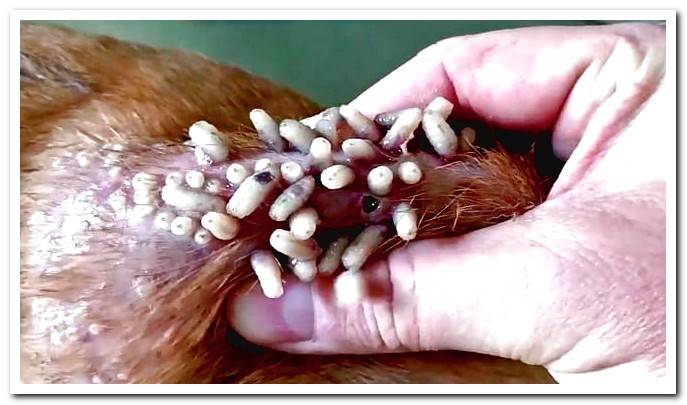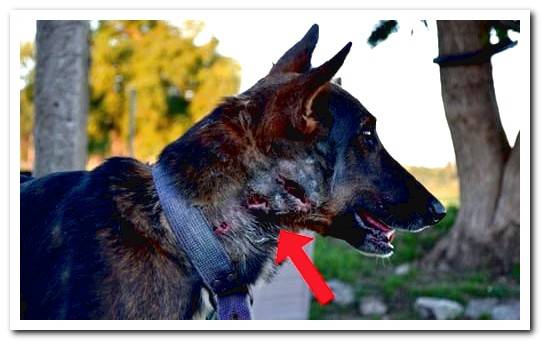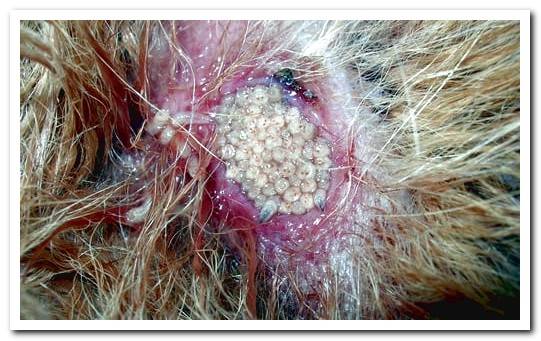
Myiasis is probably one of the most unpleasant processes that we can see in a dog. For that alone, it would be worth focusing our efforts on preventing it. Also, there is another much more important reason.
Myiasis, which is a parasitic disease in which fly larvae infect tissues and organs, can cause damage so severe that it kills the dog. Special attention must be paid to those who live abroad. Let’s see how it appears and how to prevent it.
Index of contents
- 1 What is myiasis?
- 2 Types of myiasis in dogs
- 3 When does myiasis occur?
- 4 Which dogs suffer from myiasis?
- 5 Myiasis symptoms in dogs
- 6 Treatment to cure myiasis
- 7 Fly bite dermatitis
- 8 How to prevent myiasis?
- 9 Is myiasis contagious?
What is myiasis?
Myiasis it is a parasitosis produced by fly larvae or, in general, diptera. Diptera are an order of insects among which are, in addition to flies, mosquitoes and horseflies. Diptera insect larvae infestation is triggered by the fact that adult flies lay their eggs on the dog’s body.
The areas chosen for laying are characterized by being humid and hot, which are the most suitable conditions for the development of the larvae. These areas usually correspond to skin folds, areas of frequent moisture due to tears, saliva or urine, or raw or fistulized wounds, that is, open towards the interior of the body.
Infected wounds are also affected. Another way to get to the dog’s body is by depositing the eggs in a soil from where the larvae gain access to the animal’s skin. Finally, in very dirty coats with multiple knots, the eggs can also be deposited.
Types of myiasis in dogs
There are several types of myiasis, from cutaneous myiasis to ear, nose, mouth or even anus myiasis. Being the cutaneous myiasis the most frequent, mainly when the dog has any open wound.
There may even be cases of subcutaneous myiasis, where the larvae can feed under the dog’s skin, even reaching its organs.
- Cutaneous myiasis: Dippers take advantage of wounds or moist areas of the skin to deposit their eggs, where they will remain intact until the larvae they contain grow.
- Ear Myiasis: The fly will deposit the eggs inside the ear, since it is a place where a stable humidity level is maintained and is protected.
- Myiasis of the Nose: The nose of our dogs always remains moist since this facilitates the identification of odors, which is why many mosquitoes take advantage of the nose to deposit their eggs there.
- Miasis of the Mouth: Even in a dog’s mouth, the Dipper can deposit their eggs, since they will remain moist and will be able to feed on the tissue and even food that the dog eats.
- Myiasis in the Year: It is not strange to find cases of myiasis even in the anus of the dog, since if the eggs are deposited in this cavity they will rarely be localizable and will be able to progress properly. The same goes for the eye cavities, where they can also lay their eggs.

When does myiasis occur?
In this case, we are before a problem that is usually seasonal, coinciding with the season with the greatest presence of flies. This usually coincides with the hot months. Although the dates are going to depend on where we live.
Which dogs suffer from myiasis?
Older dogs or those that are weakened for some reason are more likely to be attacked by flies. Also those who have poor hygiene and preferably live abroad.
Myiasis symptoms in dogs
Due to the action of the larvae on the skin and tissue it is easy to see lesions. These they will look like rounded holes. The eggs will hatch three days after laying. Over the next two weeks, the larvae grow. Through an enzyme in their saliva they are able to digest the skin.
This mechanism is the one cause the holes that we can appreciate. They will get bigger and bigger. The condition can be complicated by a bacterial infection. A very serious infestation can cause shock due to the action of enzymes and toxins produced by the larvae. In these cases it would be a veterinary emergency.
- Formation of boils on the affected skin or cavity
- Emergence of larvae, small worms
- Ulcers and edema on the skin that do not heal
- Intense anus itching (plurito)
- Fever
- Constant scratching, uncomfortable
- Diarrhea or even considerable weight loss

Treatment to cure myiasis
This condition has to be treated by a veterinaryn. The main thing is remove all the larvae as possible, for which a clamp can be used. In addition, all the affected tissue must also be removed. The area has to be disinfected very well. It is common to trim all the hair around.
Finally, the administration of some drug to make sure that all the larvae, in case there are any, have died. Ivermectin can be used as a subcutaneous injection. It is also possible to apply pyrethrins topically. Of course, these drugs can only be dispensed by the vet.
We cannot treat myiasis at home on our own, there are no home remedies. In specimens in which there is also a bacterial infection, antibiotics must be prescribed orally. Also, if the infestation is severe enough to cause shock, the vet will have to stabilize the dog. In these cases the forecast will be reserved.
Fly bite dermatitis
Flies can not only harm our dog by laying eggs inside. They can also bite dogs, causing dermatitis. The area that is affected is the tip of the ears in the specimens that carry them upright. This dermatitis is more common in breeds such as the German Shepherd or the Collie.
Dogs with hanging ears may also be affected, although to a lesser extent. In these cases, the bites can be seen in the folds of the ears. If we look we will see blackish crusts. In addition, they are injuries that are painful for the dog.
So we will notice it uncomfortable, it will try to scratch with its legs and will shake his head. This makes it easy for bleeding to start that can complicate the condition. When bacterial infections appear, it is necessary to treat with antibiotic ointments prescribed by the vet.
How to prevent myiasis?
Given the characteristics of myiasis, it is convenient that at least weakened or elderly do
gs are kept indoors at the time of greatest risk. This recommendation also applies to dogs that have already suffered from myiasis and are recovering.
It is best that they are not outdoors until the injuries are completely healed. If it is not possible or we want to protect it we can ask the vet for some insect repellent to keep flies away from it.
Hygiene is also essential. Ears, susceptible areas or wounds should be kept, whenever possible, clean and dry. Likewise, the cloak has to be brushed, washed and, if necessary, cut.
Is myiasis contagious?
Yes, myiasis can be spread to other animals and even humans.. That is why it is very important to detect it and treat it with the care and medications that the vet indicates. If our dog has Myiasis, it can infect other dogs and humans.
If an animal (cattle) suffers from Myiasis, it can also infect our dog. Myiasis is very contagious since the larvae always look for a host to feed on, their survival depends on it. In Youtuve you can find many videos about myiasis in dogs, but we do not recommend watching them since they contain very impressive images.
